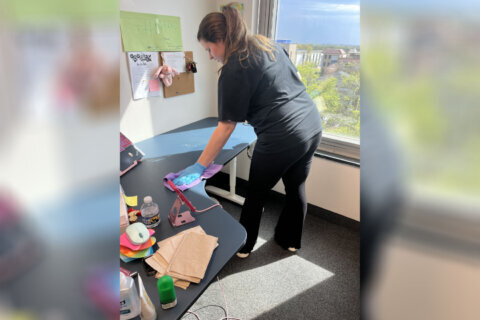U.S. homeowners spent $420 billion in 2020 on remodeling their homes, according to the National Association of Realtors 2022 Remodeling Impact Report, but not every home renovation project will increase the resale value of a home.
[Read: How Much Does It Cost to Add a Screened-In Deck or Porch to Your House?]
Before you invest in a swimming pool or new addition, you should consider whether the project will pay itself off and get prospective buyers in the door when it’s time to sell. Here are some common home improvement projects to avoid because they could decrease the value of your home:
— Too much wallpaper.
— Built-in electronics.
— Wall-to-wall carpeting.
— Swimming pool.
— Garage conversions.
— DIY projects.
— Bold colors.
— Adding a sunroom.
— Textured walls and ceilings.
— Overdone landscaping.
Too Much Wallpaper
Wallpaper is making a comeback, but a pattern and color scheme that you love may not appeal to a majority of buyers. On average, installing wallpaper costs homeowners $800 to $1,200, but most spend about $1,000 for a 12-foot-by-18-foot room with standard vinyl wallpaper, according to home improvement information site Fixr. However, this cost likely won’t be recovered when it’s time to sell.
Plus, its removal is a notoriously time-consuming and messy job. “The quality deteriorates over time and most future owners of your home will want to remove it, which can be a cumbersome process,” says Alex Capozzolo, co-founder of Brotherly Love Real Estate, a company that purchases and flips properties in Philadelphia.
Built-In Electronics
While built-in electronics may be perfect for your home theater, it could turn away prospective buyers. Not only do gadgets eventually become outdated or even obsolete, but this type of personalization can lead to a decrease in home value.
Wall-To-Wall Carpeting
“If you have existing hardwood floors, don’t cover them with carpet. Most new homeowners prefer to remove carpets if they are of poor quality. Carpeting adds no value to a property,” Capozzolo explains.
According to NAR’s Remodeling Impact Report, the highest percentage cost recovered for interior home projects was from refinishing hardwood floors at 147%, and new wood flooring at 118%. This means if you spend $20,000 on new wood flooring, you could see $23,600 added to the sale price of your home. However, this also depends on the house as well as the type and design of the hardwood floors.
Swimming Pool
Unless you live somewhere that’s hot for a majority of the year, a swimming pool won’t add much, if any, value to your home. The average cost to build a pool is around $34,065, according to HomeAdvisor, but that doesn’t factor in the cost of ongoing maintenance, which can range from $500 to $4,000 per year, and the potential increase to your homeowners insurance policy for increased liability. At the very most, a pool could increase your home’s value by 7%, according to home improvement advice site Houselogic.
[READ: Radiant Heat in Your Home: Is It Worth It?]
Garage Conversions
Most homeowners spend between $5,700 and $22,600 to convert a garage into a livable space, according to home services directory and information company Angi, but this renovation project typically doesn’t add value to the home.
“Keep the garage as is,” Capozzolo says. “As a homeowner, it’s tempting to convert your garage into a studio and rent it out or turn it into a home gym. If you alter the garage layout too much, it can lose its value in the eyes of homebuyers searching for a property with a garage to park their cars in.”
DIY Projects
DIY renovation projects can be a great budget-friendly option to add value, but if a buyer notices, it may not always be a good thing. Even simple DIY home improvement projects can go horribly wrong. Spending the extra money to have the job done well could get you a better return on your investment.
Bold Colors
Painting is one of the most common DIY projects for homeowners with a painting project ranging between $949 and $2,915, according to HomeAdvisor. A fresh coat of paint is a good way to increase your home’s final sale price, but some buyers tend to stay away from bright, dark or bold colors. If you’re looking for a cost-effective option to spruce up your home, choose neutral colors to transform the space and give each room a clean, fresh look.
Adding a Sunroom
The average cost to build a sunroom addition is about $30,000 or $25 per square foot for uninsulated spaces and up to $300 per square foot for a four-season sunroom, according to HomeAdvisor, making it one of the most expensive home improvement projects. A sunroom can seem like a good alternative to a larger home addition, but you won’t get the same return on investment. Unlike a full-room addition, sunrooms often aren’t included in a home’s square footage, which appraisers use to determine the value of a home.
Textured Walls and Ceilings
Removing texture on walls and ceilings is a difficult project, which can potentially lead to lower offers when it’s time to sell. Removing a popcorn ceiling costs homeowners between $899 and $2,862, or $1 to $2 per square foot, depending on the cost of labor and the size of the room, according to HomeAdvisor. However, asbestos, which is common in popcorn ceilings done in the 1980s or before, and structural issues can complicate the project.
Overdone Landscaping
Beautiful landscaping can help boost curb appeal and get more prospective buyers in the front door, but costly and overdone landscaping could be a concern. Not only is the attractiveness of decorative additions subjective, but buyers could see it as too difficult to maintain.
[READ:What Home Renovations Should You Make In a Recession?]
How Should Homeowners Decide if a Renovation Is Worth the Cost?
Before jumping into your next home renovation, Capozzolo says to consider the quality of life impact as well as the financial impact of the project. “If a renovation genuinely checks one of the boxes, you should consider doing it,” Capozzolo says.
“For example, painting the interior of your home with a nonneutral color will likely add zero value to your home because there’s a good chance the next owner of the property will repaint it with a different color,” Capozzolo explains. “For larger homes, painting the entire interior of your home can cost over $1,000. However, if this renovation increases your quality of life by a lot, you should highly consider it.”
More from U.S. News
Should You Renovate Your Apartment?
How Do I Find My Property Lines?
10 Home Renovations That Can Decrease the Value of Your Home originally appeared on usnews.com







